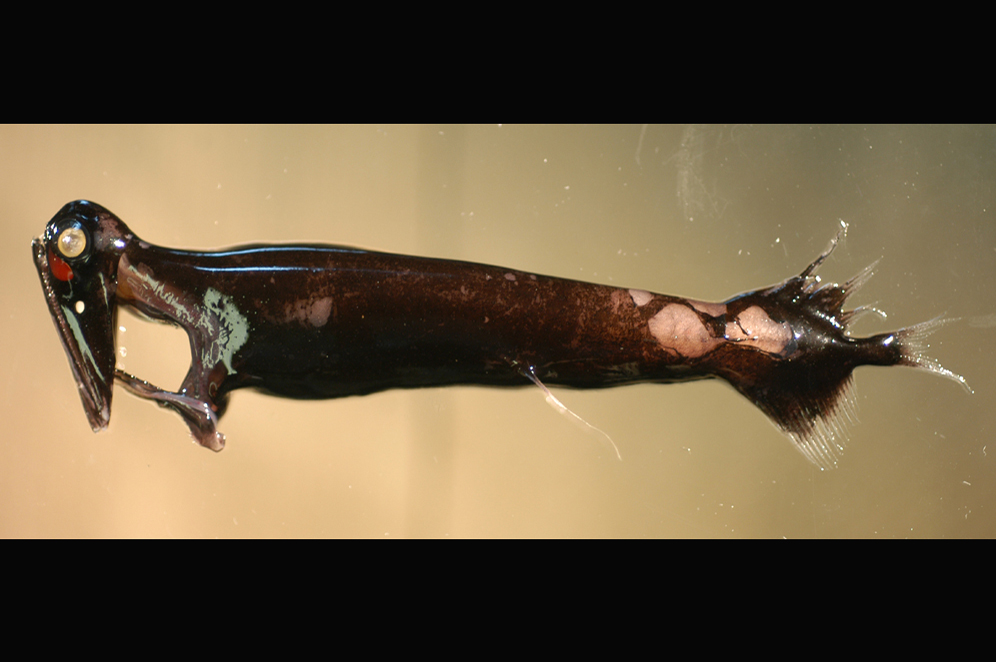Stoplight Loosejaw, Malacosteus niger Ayers 1848

A freshly caught Black Loosejaw, Malacosteus niger, showing the red light organ under the eye. Source: Chris Kenaley. License: All rights reserved
Stoplight Loosejaw, Malacosteus niger Ayers 1848
More Info
|
Distribution |
NW of Cape Leveque, Western Australia, and the Coral Sea off Cape York, Queensland; also off the Cocos (Keeling) Islands and Christmas Island in the Eastern Indian Ocean, and the Norfolk Ridge in the Tasman Sea. Elsewhere the species occurs in the tropical Atlantic and Indo-west-central Pacific. |
|
Feeding |
Loosejaws not only consume relatively large prey, they are also zooplanktivores, feeding on large calanoid copepods. |
|
Biology |
Red light cannot penetrate into the deep oceanic waters, and as a result, nearly all deep-sea animals have lost the ability to see the colour red. Most deep-sea bioluminescent animals produce a blue light. However loosejaws not only have a photophore just behind the eye that produces a blue light, they also have a large elliptical photophore under the eye that produces red bioluminescence. This allows loosejaws to shine a red light that cannot be seen by their unsuspecting prey, giving them a huge advantage in their dark environment. |
|
Remarks |
Loosejaws have a flexible connection between the occiput and the first vertebra, allowing them to swallow large prey items by bending their head far back to widen their gape. |
|
Similar Species |
The similar Malacosteus australis differs mainly in having a smaller postorbital photophore in both sexes, lower numbers of lateral photophores, somewhat smaller jaws and a fleshy orbit. |
|
Etymology |
The specific name is from the Latin niger (= black) in reference to the colour of this species. |
|
Species Citation |
Malacosteus niger Ayres 1848, Proceedings of the Boston Society of Natural History 3: 69. Type locality: Southeast of Nova Scotia, 42°N, 50°W, Canada. |
|
Author |
Bray, D.J. 2022 |
|
Resources |
Stoplight Loosejaw, Malacosteus niger Ayers 1848
References
Ayres, W.O. 1848. On a very curious fish for which the name Malacosteus niger is proposed. Proceedings of the Boston Society of Natural History 3: 69-70
Campbell, A.K. & Herring, P.J. 1987. A novel red fluorescent protein from the deep-sea luminous fish Malacosteus niger. Comparative Biochemistry and Physiology B–Biochemistry and Molecular Biology 86: 411–417.
Clarke, T.A. 1982. Feeding habits of stomiatoid fishes from Hawaiian waters. Fishery Bulletin 80: 287–304.
Douglas, R.H., Genner, M.J., Hudson, A.G., Partridge, J.C. & Wagner, H.J. 2016. Localisation and origin of the bacteriochlorophyll-derived photosensitizer in the retina of the deep-sea dragon fish Malacosteus niger. Scientific Reports 6: 39395. https://doi.org/10.1038/srep39395.
Douglas, R.H., Partridge, J.C., Dulai, K.S., Hunt, D.M., Mullineaux, C.W. & Hynninen, P.H. 1999. Enhanced retinal longwave sensitivity using a chlorophyll-derived photosensitiser in Malacosteus niger, a deep-sea dragonfish with far red bioluminescence. Vision Research 39: 2817–2832. https://doi.org/10.1016/s0042-6989(98)00332-0
Douglas, R.H., Mullineaux, C.W. & Partridge, J.C. 2000. Long-wave sensitivity in deep-sea stomiid dragonfish with far-red bioluminescence: evidence for a dietary origin of the chlorophyll-derived retinal photosensitizer of Malacosteus niger. Philosophical Transactions of the Royal Society B: Biological Sciences 355(1401): 1269–1272. https://doi.org/10.1098/rstb.2000.0681
Harold, A.S. 1999. Families Gonostomatidae, Sternoptychidae, Phosichthyidae, Astronesthidae, Stomiidae, Chauliodontidae, Melanostomiidae, Idiacanthidae, Malacosteidae. pp. 1896-1917 in Carpenter, K.E. & Niem, V.H. (eds). The Living Marine Resources of the Western Central Pacific. FAO Species Identification Guide for Fisheries Purposes. Rome : FAO Vol. 3 pp. 1397-2068.
Harold, A. 2015. Malacosteus niger. The IUCN Red List of Threatened Species 2015: e.T190149A21909439. http://dx.doi.org/10.2305/IUCN.UK.2015-4.RLTS.T190149A21909439.en. Downloaded on 01 February 2017.
Hunt, D.M., Dulai, K.S., Partridge, J.C., Cottrill, P. & Bowmaker, J.K. 2001. The molecular basis for spectral tuning of rod visual pigments in deep-sea fish. Journal of Experimental Biology 204(19): 3333-3344. https://doi.org/10.1242/jeb.204.19.3333
Kenaley, C.P. 2007. Revision of the stoplight loosejaw genus Malacosteus (Teleostei: Stomiidae: Malacosteinae), with description of a new species from the temperate Southern Hemisphere and Indian Ocean. Copeia 2007(4): 886-900. https://doi.org/10.1643/0045-8511(2007)7[886:ROTSLG]2.0.CO;2
Kenaley, C.P. 2010. Comparative innervation of cephalic photophores of the loosejaw dragonfishes (Teleostei: Stomiiformes: Stomiidae): evidence for parallel evolution of long-wave bioluminescence. Journal of Morphology 271(4):418-437. https://doi.org/10.1002/jmor.10807
Kenaley, C.P., Devaney, S.C. & Fjeran, T.T. 2014. The complex evolutionary history of seeing red: molecular phylogeny and the evolution of an adaptive visual system in deep-sea dragonfishes (Stomiiformes: Stomiidae). Evolution 8(4):996-1013. https://doi.org/10.1111/evo.12322
Kenaley, C.P., Harold, A.S. & Gomon, M.F. 2008. Family Stomiidae. pp. 240-254 in Gomon. M.F., Bray, D.J. & Kuiter, R.H (eds). Fishes of Australia's Southern Coast. Sydney : Reed New Holland 928 pp.
Kenaley, C.P. & Stewart, A.L. 2015. Subfamily Malacosteinae. pp. 524-530 in Roberts, C.D., Stewart, A.L. & Struthers, C.D. The Fishes of New Zealand. Wellington : Te Papa Press Vol. 2 pp. 1-576.
Morrow, J. E., Jr. 1964. Family Malacosteidae, pp. 523–549 in Bigelow, H.B., C.M. Breder, D.M. Cohen, G.W. Mead, D. Merriman, Y.H. Olsen, W., Schroeder, L.P. Schultz & J. Tee-Van (eds). Fishes of the Western North Atlantic. 1(4). Yale University, New Haven, Connecticut.
Schnell, N.K. & Johnson, G.D. 2017. Evolution of a functional head joint in deep-sea fishes (Stomiidae). PLoS ONE 12(2): e0170224: 1-11. https://doi.org/10.1371/journal.pone.0170224
Sutton, T.T. 2005. Trophic ecology of the deep-sea fish Malacosteus niger (Pisces: Stomiidae): an enigmatic feeding ecology to facilitate a unique visual system? Deep-sea Research Part I: Oceanographic Research Papers 52: 2065–2076. https://doi.org/10.1016/j.dsr.2005.06.011
Widder, E.A., Latz, M.I., Herring, P.J. & Case, J.F. 1984. Far red bioluminescence from two deep-sea fishes. Science 225(4661): 512-514. https://doi.org/10.1126/science.225.4661.512







